Things are winding down. The Foo Fighters wowed the crowd enough that people actually put down their iPads and laptops and gave the band a standing ovation. People are now filing out of the auditorium and walking into the hands-on area to see the new iPhone 5s with their own eyes.
“I hope you are as excited as we are,” says Mr. Cook.
Thanks for following our updates, and watch for our complete article about the event soon.
Yup, it’s the Foo Fighters, rocking out on stage in the Yerba Buena auditorium. Dave Grohl is singing “Times Like These.” I’m guessing this isn’t Apple’s signature “one more thing,” but you never know.
They’ve moved on to “There Goes My Hero.” Brings back memories: I totally slow-danced to this song in a musty bar somewhere.
Mr. Cook really should have hired Beyonce to close out the event with her hit “Upgrade U.”
Mr. Cook is back, introducing a live performance from the …. Foo Fighters?
A new 2-gigabyte iPod shuffle costs $49, and the 16-gigabyte Nano costs $149. The older 16-gigabyte iPod Touch is now $199, while the 32-gigabyte one costs $249. The new, souped-up iPod Touch starts at $299 for the 32-gigabyte model.
Audio technology is serious business for Apple. The company is showing a super-scientific video detailing how its new earbud design boosts the acoustic chamber in the ear, or something, and how sound travels from its earbuds into a user’s ear canal. It’s hard not to read this as a dig at HTC and Beats by Dre, which have teamed up to release special audio technology and headsets with HTC smartphones.
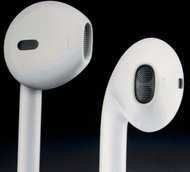 Beck Diefenbach/Reuters
Beck Diefenbach/Reuters
Looks like Apple’s refreshing all of its accessories. In addition to rolling out new connector cords, the company is releasing a new version of its headphones, called EarPods. To date, the company has shipped 600 million of its signature white earbuds.
The new iPod Touch will also have Siri, so that should keep the kids entertained for awhile. Also, yellow is apparently the new black as well, because the new Touch comes in yellow, as well as blue, black and red. (Anyone else think they look kind of like a Lumia?)
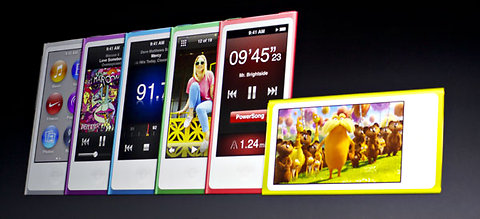 Nick Bilton/The New York Times
Nick Bilton/The New York Times
More details on how the iPod Touch is stepping up its game: It will allow 40 hours of music playback and 8 hours of game play. Apple’s including a 5-megapixel camera with a flash on the new Touch, one that will have the same lens as the iPhone 5.
David Pogue notes on Twitter: “There’s a tiny metal circle on the back of the new Touch. Push it, it pops up, so you can attach a wrist strap.” Apple’s bringing back the wallet chain?
The crowd is loving a demo of a game called Clumsy that lets players mess around with a cute ninja character.
The iPod Touch is Apple’s prime gaming machine, with access to 175,000 games and entertainment apps. The company is introducing a skinnier version of the Touch, one that weighs 88 grams, is 6 millimeters wide and features the company’s high-resolution “retina” display. The Touch is also getting the A5 chip, giving the machine a boost in handling graphics.
The new Nanos have multitouch screens. Runners will be able to make use of a pedometer and Nike+ apps. Bluetooth integration will let users send music to their car stereos and wireless speaker systems like Jawbone’s Jambox.
We’ll aim to answer your questions about the Apple announcements. Leave a comment on this post and our reporters will pick a batch to answer.
To date, Apple has sold 350 million iPods. Apple is rolling out a new version of its Nano, the seventh edition of the smallest iPod. It is razor-thin, as in 5 millimeters, and uses the new Lightning connector tech. It comes in seven colors.
One of the cooler features of the new iTunes redesign: Users will be able to see upcoming concerts and other information about the artists in their library. Very similar to some of the offerings in Spotify. The update will roll out in late October.
The new iTunes looks very similar to Rdio, the streaming music service, with square music covers in the middle of the screen, playlists and account info on the side.
— Nick Bilton
The new iTunes incorporates iCloud right into it, meaning that users who are watching a movie on one device, like an iPad, can seamlessly pick it up on another device, like an iPhone.
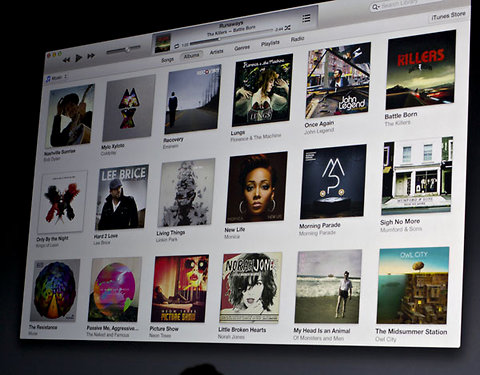 Nick Bilton/The New York Times
Nick Bilton/The New York Times
Apple now has more than 200 million customers using iTunes in the cloud, Mr. Cue says. In addition to introducing a new iTunes Store app, Apple has also upgraded iTunes for the Mac. The new iTunes makes it easier to create playlists for parties — you can quickly browse through a library and drag and drop songs into groups.
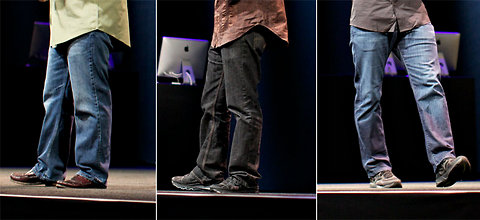 Nick Bilton/The New York Tiumes
Nick Bilton/The New York Tiumes
So it seems that it is now standard for Apple executives to come on stage with their shirt untucked: Mr. Cook, Mr. Schiller and now Mr. Cue. What’s next, Birkenstocks?
— Nick Bilton
Eddy Cue, Apple’s senior vice president for Internet software and services, is on stage talking about upgrades to music. Apple has 435 million iTunes accounts on file. And the company is releasing a new version of iTunes. More than two-thirds of iTunes purchases come through iOS devices, so Apple revamped iTunes to reflect that, Mr. Cue says. ITunes customers can now share information about their purchases through Facebook and Twitter.
Mr. Schiller says the starting price of the iPhone 5 will be same as previous phones, $199 with a two-year contract and 16 gigabytes. The iPhone 4S will go to $99. The iPhone 4 will be free with contract. The phone goes on sale Sept. 21. Apple will start taking orders for the new phone on Friday, and hopes to have it in 100 countries by the end of the year.
The video is showing off some of the splashier features of the new iPhone and operating system, like the maps, Siri’s souped-up capabilities and the ability to make FaceTime calls over cellular networks.
And here’s the iPhone 5 video: Jonathan Ive talking about the iPhone like he just met the woman of his dreams. I need a Kleenex.
— Nick Bilton
Apple is expanding its Siri voice assistant in iOS 6 so you can get sports stats and movie recommendations and make restaurant reservations. You can post directly to Facebook with Siri by dictating status updates, Mr. Forstall says.
— Nick Wingfield
The new Apple maps feature is another way Apple is slowly eliminating Google from iOS. As the new maps app will work on the iPad, too, it will be interesting to see if it will eventually come to Macs.
— Nick Bilton
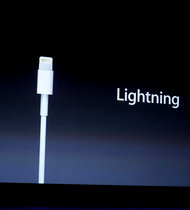 Peter DaSilva for The New York Times
Peter DaSilva for The New York Times
Apple hasn’t given a clear sense of why it changed the connector, other than it being smaller. I’d assume it’s to make the battery larger, but I’m surprised there was no explanation of a real benefit, like faster data speeds.
— Brian X. Chen
Scott Forstall, who is in charge of iPhone software at Apple, is on stage now, giving us a tour of iOS 6, the next version of Apple’s mobile software, on the iPhone 5. Apple’s new Maps feature will include turn-by-turn navigation and three-dimensional maps, and will show users places they might be interested in checking out, like restaurants and coffee shops.
Mr. Schiller is introducing the new iPhone connector cord, which is called Lightning. He says its more durable, reversible and “80 percent smaller.” The new cord technology is already embedded in many third-party systems. But before you start freaking out about having to rush out and buy new cords: Apple will also be selling an adapter, so all of those drawers full of old Apple chargers and connectors won’t have to go to waste.
Apple is gussying up its phone-calling technology — for those who still bother to make phone calls. The iPhone 5 is outfitted with three microphones and a noise-canceling earpiece.
Finally — the phone’s front-facing camera gets an upgrade, meaning that FaceTime conversations will no longer make video chatters cringe.
Mr. Schiller notes that these photos are from the iPhone 5’s actual camera, “untouched.” Seems to be a knock on Nokia, which got flack for a misleading video that wasn’t actually shot with its newest phone.
— Brian X. Chen
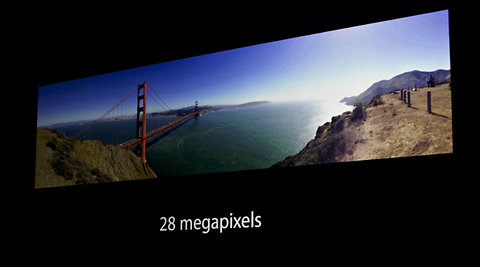 Nick Bilton/The New York Times
Nick Bilton/The New York Times
The new iPhone 5 camera will let users share their photo streams with friends. In addition, the camera has special software that will let users take panoramic photographs. Mr. Schiller is showing off a nice picture of the Golden Gate Bridge and bragging about its quality.
The iPhone camera is getting an upgrade. It now has an 8-megapixel sensor, backside illumination and a five-element lens. The improvements will be a big boon for low-light photography, typically the iPhone’s Achilles heel. The iPhone also includes a sapphire crystal to sharpen images, as well as systems to reduce digital noise and speed up the time it takes to snap a picture.
The guy behind me just moaned. “Geez, that’s really nice.”
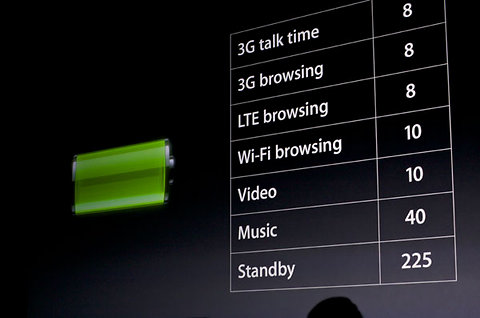 Nick Bilton/The New York Times
Nick Bilton/The New York Times
Mr. Schiller’s back. The iPhone 5 has a larger, juicier battery, which includes 8 hours of 3G talk time, 8 hours of LTE browsing and 10 hours on Wi-Fi, he says.
Rob Murray, executive producer at Electronic Arts Studios, just took the stage to demonstrate a racing game. It looks crisp and real. This could be a big deal for apps makers, large and small.
The new machine has speedier innards, thanks to a new A6 chip designed by Apple. The chip is twice as fast in terms of CPU and graphics, Mr. Schiller says. “Not only is it a jump forward in performance, it’s 22 percent smaller,” he says. The chip means Web pages load twice as fast.
Good news for those sick of dropped signals and sluggish iMessage delivery: The iPhone 5 has chips that support additional bands and frequencies. It can handle HSPA+, DC-HSDPA and most importantly LTE, capable of delivering up to 100 Mbps per second. Mr. Schiller is detailing the carrier partners for the new iPhone: ATT, Verizon, Sprint, Telefonica, to name a few, in Europe, Australia, Asia.
Now, Mr. Schiller is demonstrating how the roomier screen of the iPhone 5 can be used by apps makers. The screen has 40 percent more color saturation, he says, which is the “most accurate display in the industry.”
He’s showing off new versions of a CNN app and an OpenTable app that takes advantage of the larger screen, giving more space for details and photographs.
The iPhone’s width is just right for navigating with your thumb, says Mr. Schiller, to make it easy to send text messages, swipe through pages and browse the Web. Seems like a dig at Android devices with wider screens.
The additional vertical space on the iPhone 5 screen will let users add a fifth, additional row of apps on the home screen — more room for Web browsing and reading, Mr. Schiller says.
The actual iPhone 5 matches previously leaked images from Asia. This shows that it’s gotten tough for Apple to maintain its culture of secrecy with so many component partners overseas.
— Brian X. Chen
It’s the thinnest phone ever made, says Mr. Schiller. It is 7.6 millimeters thick, or 18 percent slimmer than the iPhone 4S. The phone weighs 112 grams, which is 20 percent lighter than the previous iteration. The new screen is a 4-inch display, with the same high-resolution 326 pixels per inch as the previous version. It’s 1,136 by 640 pixels, 16×9 aspect ratio.
The next-generation iPhone emerges from the stage, riding on a pedestal. “It is an absolute jewel,” he says. “The most beautiful product we’ve made, bar none.”
It’s made of aluminum and steel, he said.
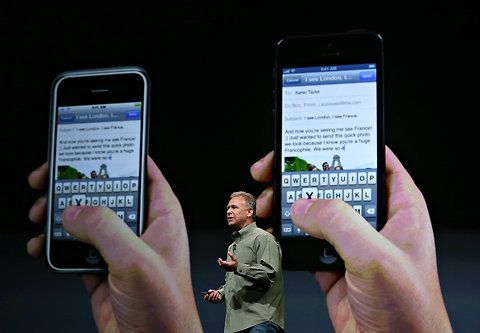 Justin Sullivan/Getty Images
Justin Sullivan/Getty Images
Mr. Schiller is walking us through each version of the iPhone. “Today, we’re going to introduce the iPhone 5,” he says.
Last quarter, Apple sold its 400 millionth iOS device. “Today, we’re taking it to the next level,” Mr. Cook says. Phil Schiller, Apple’s marketing chief, is taking the stage.
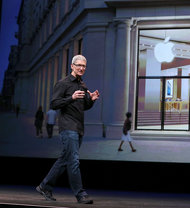 Justin Sullivan/Getty ImagesTim Cook, Apple’s chief executive.
Justin Sullivan/Getty ImagesTim Cook, Apple’s chief executive.
Mr. Cook, normally Mr. Nice Guy, is being funny and sarcastic. Noting that the iPad accounts for 91 percent of tablet Web traffic, Mr. Cook says, “I don’t know what these other tablets are doing.” (The crowd laughs, of course.)
— Nick Bilton
Apple now has 700,000 apps in the store, 250,000 for the iPad alone. That number elicited a few whistles and a loud smattering of applause. “There’s something in the App Store for everyone,” Mr. Cook says. The average customer is using more than 100 apps, he says.
Now Mr. Cook is talking about the latest iPad. It was announced in March, and the company sold 17 million iPads in the last quarter. “Yes, we are in a post-PC world,” Mr. Cook says. In total, there have been 84 million iPads sold through June. The iPad, said Mr. Cook, has 62 percent of the worldwide tablet market.
Mr. Cook says Apple customers have downloaded 7 million copies of the company’s latest Mac operating system, Mountain Lion, “making it the fastest-selling OS of all time.” In July, MacBook laptops grabbed a 27 percent share of the overall laptop market, he says.
Apple now has 380 stores in 12 countries, with the next one opening on Friday, Mr. Cook says. Apple is opening its first store in Sweden. Mr. Cook says 83 million customers visited Apple stores in June.
Mr. Cook is walking on stage, wearing a nice black button-down and blue jeans. He’s showing off photographs of an Apple flagship store in Barcelona. “It’s an amazing time at Apple, an extraordinary time.” He’s showing a video of an Apple store in Barcelona.
We’re here in the auditorium, people are filing in and the room is brimming with journalists, noted Silicon Valley venture capitalists like Ron Conway, and well-known apps makers like Ge Wang, founder and chief executive of Smule. Spotted in the front row: Al Gore.
Article source: http://bits.blogs.nytimes.com/2012/09/12/live-updates-from-the-apple-iphone-event/?partner=rss&emc=rss